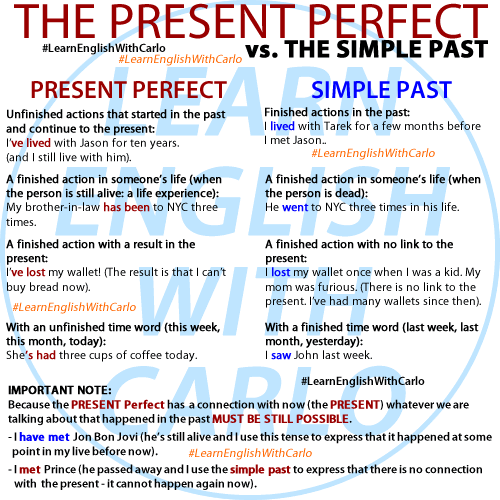
When learning English, one of the most challenging aspects for students is understanding the difference between the Present Perfect and the Simple Past. Both tenses refer to actions in the past, but they are used in very different ways depending on the context. Let’s break down these differences.
Present Perfect: Unfinished Actions
The Present Perfect is used to describe actions that started in the past and continue to the present. The action may not be ongoing, but the impact of the action remains.
- Example: I’ve lived with Jason for ten years.
(I still live with him.)
In this sentence, the action of living with Jason began in the past and continues to this day.
Simple Past: Finished Actions
The Simple Past is used for completed actions that occurred at a specific point in the past. These actions are not connected to the present moment.
- Example: I lived with Tarek for a few months before I met Jason.
In this case, living with Tarek is a finished action with no connection to the present. It occurred before meeting Jason and is no longer relevant.
Present Perfect: Life Experiences (Unfinished Life)
When we talk about life experiences, we often use the Present Perfect, especially if the person is still alive and could possibly repeat the experience.
- Example: My brother-in-law has been to NYC three times.
Since the brother-in-law is still alive, he might go to New York City again, making this a relevant life experience.
Simple Past: Life Experiences (Finished Life)
If we are talking about someone who has passed away, or if we are referring to something that can no longer happen, we use the Simple Past.
- Example: She went to NYC three times in her life.
Here, the person is no longer alive, so this action belongs to a finished past.
Present Perfect: Actions with Present Results
The Present Perfect is also used when a past action has a result in the present. This emphasizes the connection between the past event and the current situation.
- Example: I’ve lost my wallet!
The result of this is that you are still experiencing the consequences in the present, such as being unable to buy something.
Simple Past: No Present Connection
In contrast, the Simple Past is used when a past action has no effect on the present. The action is fully completed, and there is no ongoing relevance.
- Example: I lost my wallet once when I was a kid. My mom was furious.
This event happened long ago and has no connection to the present moment.
Present Perfect: Unfinished Time Periods
We use the Present Perfect when the time period being discussed is unfinished or ongoing. Words like “this week,” “this month,” and “today” indicate that the time frame is still open.
- Example: She’s had three cups of coffee today.
Since “today” hasn’t ended yet, the Present Perfect is the appropriate tense.
Simple Past: Finished Time Periods
When the time period is finished or clearly in the past, we use the Simple Past. Words like “yesterday,” “last week,” or “last month” signal that the time frame is complete.
- Example: She had three cups of coffee yesterday.
“Yesterday” is a finished time period, so we use the Simple Past.
Important Note
The Present Perfect is connected to the present moment because it often describes situations that are still possible or ongoing. This tense suggests that the past event could still have some relevance today.
- Example: I have met Jon Bon Jovi.
(He’s still alive, so it’s possible that I could meet him again.)
On the other hand, the Simple Past is used for actions that are entirely in the past, with no connection to the present.
- Example: I met Prince.
(Since Prince has passed away, it’s impossible to meet him again. The action belongs completely to the past.)
Conclusion
Understanding the difference between the Present Perfect and the Simple Past is essential for expressing yourself clearly in English. The Present Perfect links the past to the present, while the Simple Past separates the action from the present. Keep practicing these distinctions, and soon they will become second nature!
